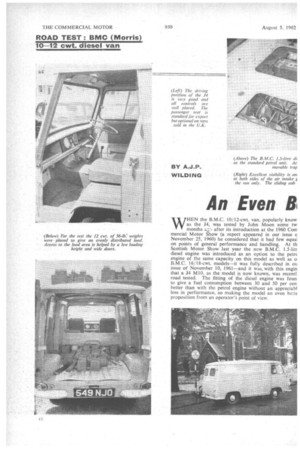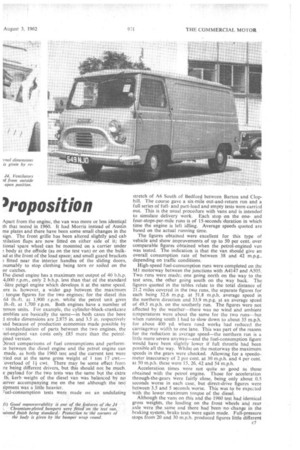An Even proposition
Page 48

Page 49

Page 50

Page 53

If you've noticed an error in this article please click here to report it so we can fix it.
W. HEN the B.M.C. 10/12-cwt. van, popularly know as the J4, was tested by John Moon some tw months 4. after its introduction at the 1960 Corr mercial Motor Show (a report appeared in our issue c November 25, 1960) he considered that it had few equal on points of general performance and handling. At th Scottish Motor. Show last year the new B.M.C. 1.5-litr diesel engine was introduced as an option to the petr( engine of the same capacity on this model as well as o B.M.C. 16/18-cwt. models—it was fully described in ou issue of November 10, 1961—and it was, with this engin that a J4 M10, as the model is now known, was recent] road tested. The fitting of the diesel engine was foun to give a fuel consumption between 30 and 50 per cen better than with the petrol engine without an appreciabi loss in performance, so making the model an even bete proposition from an operator's point of view. Apart from the engine, the van was more or less identical th that tested in 1960. It had Morris instead of Austin me plates and there have been some small changes in the sign. The front grille has been altered slightly and cab atilation flaps are now fitted on either side of it; the tional 'spare wheel can be mounted on a carrier under body at the offside (as on the test van) or on the bulkad at the front of the load space; and small guard brackets t fitted near the interior handles of the sliding doors, tsumably to stop clothing being torn or soiled on the or catches.
The diesel engine has a maximum net output of 40 b.h.p. 4,000 r.p.m., only 2 b.h.p. less than that of the standard -litre petrpl engine which develops it at the same speed. ere is, however, a wider gap between the maximum torque figures for the two engines; for the diesel this 64 lb.-ft. at 1,900 r.p.m. whilst the petrol unit gives lb.-ft. at 1,700 r.p.m. Both engines have a number of -nmon units. For example, the cylinder-block-crankcase emblies are basically the same—in both cases the bore I stroke dimensions are 2.875 in. and 3.5 in. respectively Ind because of production economies made possible by ! standardization of parts between the two engines, the sel-engined van costs only £85 more than the petroltined version.
3irect comparisons of fuel consumptions and perform:e between the diesel engine and the petrol engine can made, as both the 1960 test and the current test were Tied out at the same gross weight of 1 ton 17 cwt.— overload of 11cwt. There may be some effect from re being different drivers, but this should not be much. e payload for the two tests was the same but the extra lb. kerb weight of the diesel van was balanced by no ;elver accompanying me on the test although the test iipment was a little heavier.
Fuel-consumption tests were made on an undulating stretch of A6 South of Bedford between Barton and Clophill. The course gave a six-mile out-and-return run and a full series of fulland part-load and empty tests were carried out. This is the usual procedure with vans and is intended to simulate delivery work. Each stop on the oneand four-stops-per-mile runs is of 15-seconds duration in which time the engine is left idling. Average speeds quoted are based on the actual running time.
The figures obtained were excellent for this type of vehicle and show improvements of up to 50 per cent. over comparable figures obtained when the petrol-engined van was tested. The indication is that the van should give an overall consumption rate of between 38 and 42 m.p.g., depending on traffic conditions.
High-speed fuel-consumption runs were completed on the MI motorway between the junctions with A4147 and A505. Two runs were made; one going north on the way to the test area, the other going south on the way back. The figures quoted in the tables relate to the total distance of 21.2 miles covered in the two runs, the separate figures for each being 32.6 m.p.g. at 51.8 m.p.h. average speed in the northern direction and 33.9 m.p.g. at an average speed of 49.5 m.p.h. on the southerly run. The figures were not affected by the weather—there was no wind and ambient temperatures were about the same for the two runs—but when running south 1 had to slow down to about 35 m.p.h. for about 400 yd. where road works had reduced the carriageway width to one lane. This was part of the reason for the reduction in average speed—the northern run is a little more severe anyway—and the fuel-consumption figure would have been slightly lower if full throttle had been possible all the way. Whilst on the motorway the maximum speeds in the gears were checked. Allowing, for a speedo-. meter inaccuracy of 2 per cent. at 30 m.p.h. and 4 per cent. at 50 m.p.h. these were 15, 26, 42 and 54 m.p.h.
Acceleration times were not quite so good as those obtained with the petrol engine. Those for acceleration through-the-gears were fairly close, being only about 0.5 seconds worse in each case, but direct-drive figures were between 3.5 and 5 seconds worse. This was to be expected with the lower maximum torque of the diesel.
Although the vans on this and the 1960 test had identical gross weights, the loading on the front wheels and rear axle were the same and there had beenno': Change in the braking system, brake tests were again made. Full-pressure stops from 20 and 30 m.p.h. produced figures little different from those recorded in the original test. From 20 m.p.h. the stopping distance was 4 in. less and from 30 m.p.h. it was just over 2 ft. more. The van was again remarkably stable and the reason for the increased stopping distance from the higher speed was undoubtedly due to the fact that the tests were completed on a relatively smooth, tarred road and not the concrete road used previously. The braking tests were, incidentally, the only ones not carried out over the same roads used on the 1960 test.
A slightly better hill-climbing performance was put up by the diesel-engined van. Bison Hill was again used for the c8 tests. The hill is 0.75 miles long, has an average gradie of 1 in 10.5 with a maximum gradient of 1 in 6.5. maximum-power ascent was made in 2 minutes 27 secon (12 seconds less than the petrol engined version) of whi 45 seconds was spent in second gear-the lowest us( Second gear was also the lowest used on the 1960 test b it was then in use for 55 seconds. The minimum speed both this and the 1960 run was 14 m.p.h.
Because the ambient temperature on this test was mu higher than on the 1960 test, it is not possible to compa tiencies of the cooling systems of the two engines. ring the climb with the diesel van, the ambient tempera! was 21° C. (70° F.) and the temperature increased it 67.5° C. (154° F.) at the bottom of the hill to C. (181° F.) at the top.
• Fade from Linings
arti-fade characteristics of the brakes were assessed on esc,ent of the hill. The run down was made in neutral the footbrake applied to keep the 'speed of the van 20 m.p.h. Where the gradient is less, steep near the torn of the hill, I engaged top gear, applied full throttle kept the brakes on so that the speed stayed at 20 m.p.h. riaximurn-pressure brake stop from 20 m.p.h. at the end he run produced a Tapley meter reading of 65 per cent., 'op of 28 per cent, compared with the cold-drums figures lined on the braking tests earlier in the day. There was increase in the brake pedal travel, an indication that the Iction in efficiency was due to the linings. The total e for the descent was 2 minutes 45 seconds of which ;econds had been spent in top gear.
M a second ascent of the hill, stop-and-restart tests were le on the 1-in-6.5 gradient. Easy restarts in bottom and .rse gears were made when facing up and facing down hill respectively on this incline and the handbrake held van with notches to spare in both positions: ,s far as general handling and body layout of the J4 are cerned, I formed general impressions similar to those ch John Moon recorded in his 1960 test of the model. Fund the van very, pleasant to drive in all traffic condi tions— a virtue backed up by a smooth engine, by small diesel standards, and a generally low noise level at all times. The steering was not unduly heavy and commendably responsive for a full-forward-control van Of, its type and visibility and manceuvrability were of a -high standard. To obtain adequate performance to keep up with traffic, the gearbox had to be used fully, but the floor-mounted change had an easy action although the reversed gate took a little getting used to.
Good Suspension
At high speed on the motorway, the van handled particularly well and at over 50 m.p.h. on the sections with a fairly rough surface the, suspension stood the strain admirably: the shocks were not transmitted to the steering wheel and the van stayed on a straight course without any correction on my part. The suspension was very good generally. There was little fore and aft pitching although there was some sideways roll on sharp corners taken quickly.
Access to the driving and load areas are important points on delivery vans and the 14 is well designed from both aspects. The driving seat can be reached easily from either the nearside or offside doors. Sliding doors were fitted on the van tested (hinged doors are optional) and in addition to easy access these were found to have the advantage that they could be fixed in the open position to give adequate ventilation in the warm weather when the van was tested. The sliding windows and the vent flaps at the front of the van allowed insufficient ventilation to counteract the large quantities of warm air which entered the van through a wide gap at the rear of the engine cowl —which itself become uncomfortably hot. I also found it difficult to give hand signals due to the small opening left when either section of the side windows was open.
Maintenance tests were not carried out on the van tested because a full series was completed on the petrol-engined van in 1960. In the ease of the engine, checking the oil level would have taken the same time although the air cleaner is of a different design. There did not appear to be any difficulties in the way of checking the oil level in the cleaner. Similarly, changing injectors should present no problems.
As tested the .14 would have cost £596 12s., this figure being made up of £555 basic price plus £10 for painting, £15 17s. for the spare wheel and carrier (when mounted inside the van the price is £12 17s.), £8 15s. for the passenger seat, £6 for the chromium-plated bumpers and fl for the two sun visors. For its price and with all its good points, this B.M.C. van must present great appeal to operators of this class of vehicle, which explains the large number seen on the roads in this country.
































































































